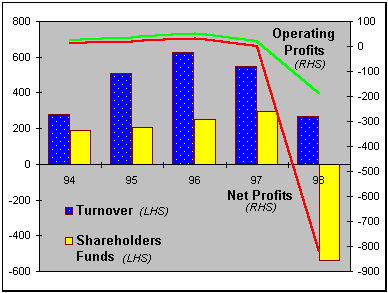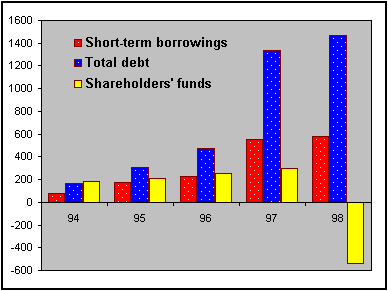|
Mancon is a mid-size construction and property developer, with investments in Hangzhou, China and Hong Kong. The group's principal activities included civil engineering and building contracting works, property development and investment, supply of building and construction materials and operations of a quarry. During the period between 1994 to 1996, Mancon's turnover, operating profits, net profits and shareholders' funds were charting a steady upward trend until signs of deterioration emerged in 1997, culminating in the disastrous fiscal year of 1998 (see figure 1). The group's shareholders' funds disintegrated from a healthy RM295 mln in 1997 to a deficit of RM538.7 mln in 1998. A massive RM833.7 mln of shareholders' wealth was wiped out in a single year. What happened?

Figure 1 : Financial highlights of Mancon (RM mln)
a) Rapid Expansion
Globalisation Programme
It all began in 1994, under the group's globalisation programme. The group's management sought to expand its operations into the neighbouring Asian countries, which were expected to experience high economic growth in the years to come. First, its wholly-owned subsidiary, Absolute Alliance S/B, purchased 75% of the paid-up capital of Cosmos Crown Investment Ltd for HK$4.5 mln. The principal asset of Cosmos Crown was the entire ownership of Hang Zhou Golden Horse Real Estate Co Ltd, a company incorporated in China. Subsequently, the group entered into a construction contract with Hang Zhou Golden Horse Real Estate Co Ltd to build Hang Zhou Dream Lake Villa, which included villas, apartments, hotels and other public facilities for a contract value of approximately US$105 mln. Then, Mancon had equity participation in Hang Zhou Future World Recreation Co Ltd, a resort and theme park operating company in China, and a construction company in the Philippines.
By the end of 1996, the group had an impressive looking turnover of RM627.5 mln, which generated RM32.2 mln in profits. In Aug 97, the group's overseas venture, Future World Theme Park, developed by Hang Zhou Future World Recreation Co Ltd, was finally opened with its prospects looking good at that time.
Local Expansion
On the home front, the group acquired Wangsa Idaman in Dec 1994 for RM74.5 mln (cash payment of RM12.05 mln with the rest paid via 10.07 mln shares priced at RM6.20 each) to develop the 506 acres of land into an industrial park, known as Senai Industrial Park. At that time, its bank borrowings were at a manageable RM78.8 mln, with shareholders' funds of RM187.2 mln. In 1995/96, the group expanded rapidly and successfully secured construction projects, notably the KL-Putrajaya-KLIA Expressway project and the Capital Square project with an approximate contract value of RM2.0 bln.
Disaster Struck
By late 1997, the severe economic downturn in the region affected Mancon enormously, especially in the construction and property sectors. The postponement and cancellations of its construction projects curtailed its core operations. Revenues from the construction division posted a 50% drop in 1998 while its property development and trading divisions posted a 90% drop in revenue. The sharp increase in interest rates worsened the high cost of financing. As a result, in 1998 it posted an operating loss of RM187 mln with losses of RM123.2 mln in the construction division alone. More bad news was to be announced. The group discovered that the titles of land use rights in its subsidiaries in Hong Kong, Winkay Investment Ltd and Gain Union Investment Ltd, were in doubt and had to write-off some RM82.2 mln worth of properties. Winkay Investment Ltd owned Hang Zhou Dream Lake Serviced Co Ltd while Gain Union Investment Ltd owned Hang Zhou Future World Recreation Co Ltd. Furthermore, stocks of Cosmos Crown Investment Ltd, its subsidiary in HK, had to be written-off as titles to the properties were also doubtful. In total, Mancon incurred exceptional losses amounting to a staggering RM660 mln, of which RM327 mln were due to stocks and properties written-off in HK.
b) Over-geared and Overstretched
Ignoring Basic Financial Management
In order to fund its rapid local and overseas expansion, the group did a private placement in Aug 1997 of 11.297 mln shares priced at RM3.65 each. It also made huge drawdowns of short-term borrowings and foreign funding was also sought. As an example of this, Mancon (BVI) Investment Holding Co Ltd, the group's wholly-owned subsidiary, in May 1997 issued US$100 mln in Guaranteed Floating Rate Notes to finance its various international projects. Therefore, although the group's shareholders' funds increased by 58% between 1994 and 1997, its short-term borrowings and total debt unbelievably increased by 6 and 7-fold respectively (see figure 2). By 1997, the group's total debt stood at a massive RM1.33 bln, requiring an annual interest expense of RM37.5 mln. Its gearing ratio was uncomfortably high at approximately 4.5 times, signalling an extremely risky and vulnerable financial structure. Corporate guarantees alone amounted to RM288.5 mln. Would it be able to generate sufficient cash flows to maintain its ongoing operations, service its annual interest expenses and repay the principals due ? Simple common sense would have said no. Even in the best of times, it would be tough but considering what was brewing in the region, the odds were definitely stacked against the group.

Figure 2 : Debt and Capital Structure of Mancon (in RM mln)
Financial Collapse
Due to the group's inability to generate sufficient cash flows from its operations, not surprisingly, it subsequently defaulted on its loan and interest payments, which then started a spiral of events leading to its financial ruins. Its interest expense of RM100.9 mln in 1999 would virtually wipe out whatever profits it had. Hence, Mancon, in Oct 1999, fell under receivership and later in February 2001, was deemed to be an affected listed issuer under the PN4 category.
|



